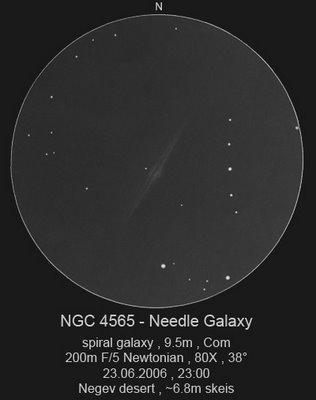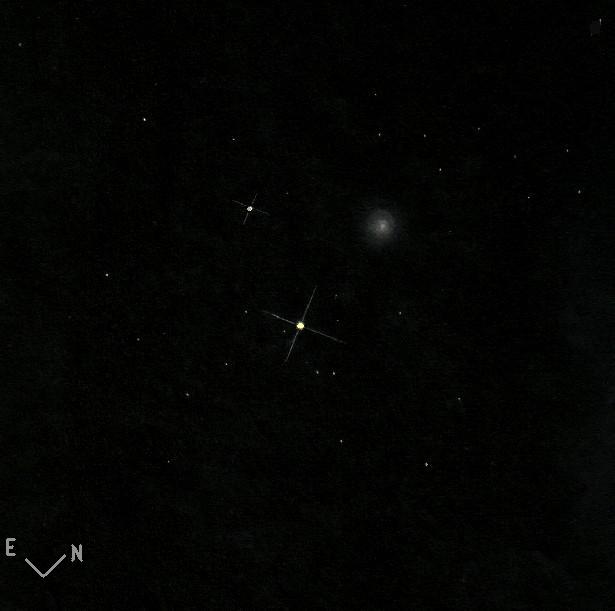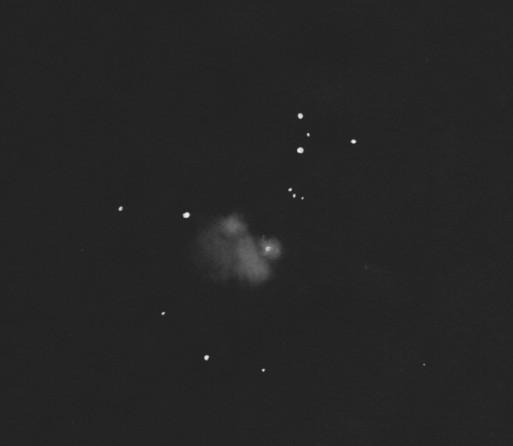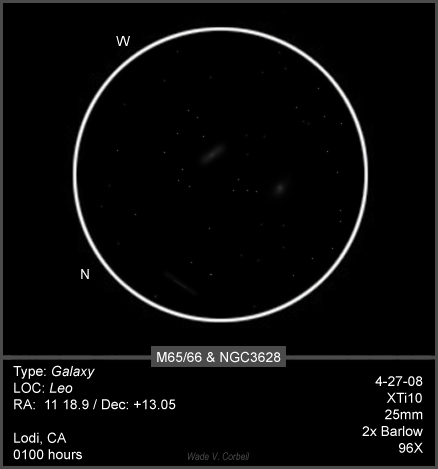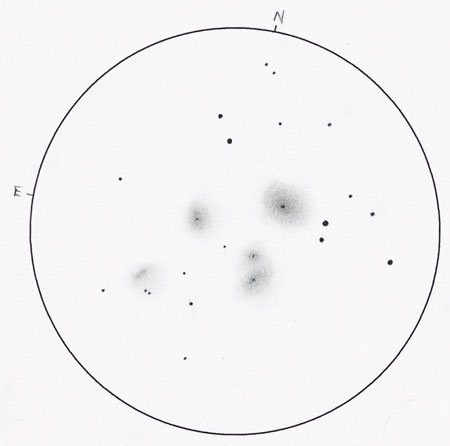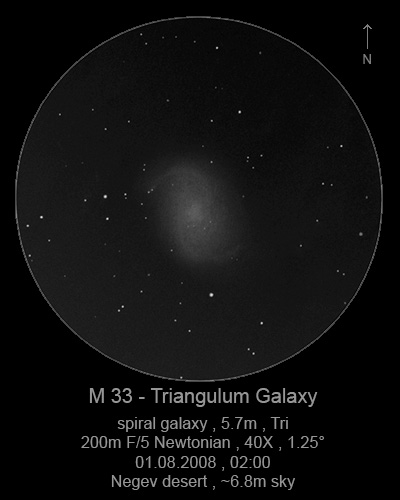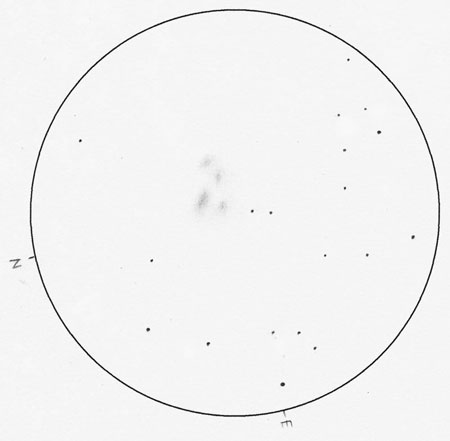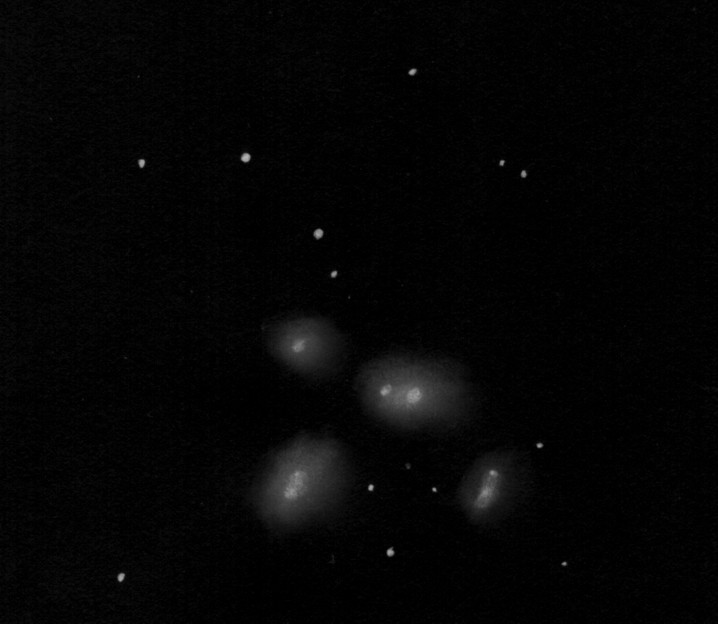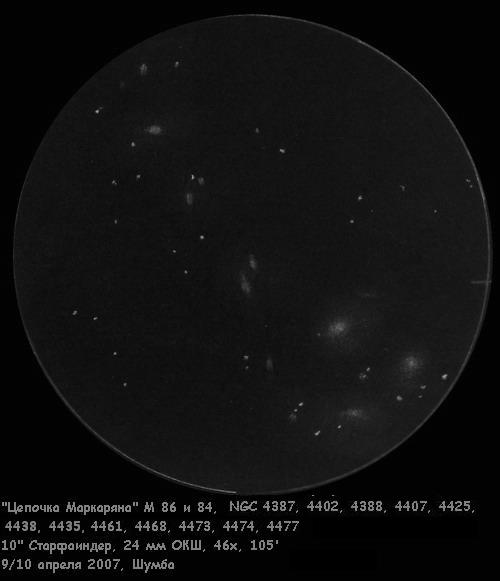NGC 4565
Sketch by Michael Vlasov
Category: Galaxy
Mirach and its Ghost
Mirach and NGC 404
Sketch and details by Frank McCabe
As the constellation Andromeda climbed high in the eastern sky, I used this opportunity to sketch dwarf spiral galaxy NGC 404 and nearby second magnitude star Beta Andromedae (Mirach). Beta Andromeda is a red giant star of class M0 III and 199 light years from us. This bright star appeared golden to my eye and is a mere 6.5 arc-minutes from its “ghost” the galaxy NGC 404. This 10th magnitude galaxy has been classified as E0, lenticular (a category between elliptical and spiral) and more recently spiral class S0. At a distance of 10 million light years it is 50,000 times further away than Mirach. William Herschel described NGC 404 as a nebula in 1784. The position of galaxy is approximately R.A 1hr 10min, Dec. +35° 37’.
I made this sketch in the early morning of August 31, 2008.
Sketching
Date and Time: 8-31-2008, 5:10-5:40 UT
Scope: 18” f/5 Dobsonian. 175x
8”x11” white recycled sketching paper, 4B soft charcoal pencil, HB hard charcoal pencil, blending stump, eraser shield, drawing re-sketched indoors because of much smudging, scanned and inverted, some star magnitude adjustments made after scanning using Microsoft Paint.
Seeing: Pickering 7/10
Transparency: Above Average 4/5
Nelm: 4.8
Frank McCabe
Octans Triplet
NGC 6438 and 6438A
Sketch by Eiji Kato
The complex multiple galaxy, NGC 6438 lies in the southern constellation Octans. According to analysis by C. J. Donzelli and M. Espindola in NGC 6438: A Triple System?, this may be an interacting triplet (an S0 galaxy and two disc galaxies in a merger) rather than a double system.
Rewarding Quarry in Leo
M65, M66 and NGC 3628 – The Leo Triplet
Sketch and details by Wade V. Corbei
Here is a sketch from a few months back that I finally got around to digitizing. It is commonly referred to as the “Leo Triplet”, and consists of two (2) Messier objects and a NGC object: M65, M66 & NCG3628 respectively.
This was a fun find, which, up until now, I had never been able to remotely locate with my old 70mm. This past year has been full of great finds such as these (at least for me); as my observing experience with my new scope (one year old on 8-14-08 ) has just been phenomenal and beyond my expectations.
Hickson 68: Galaxy Cluster in Canes Venatici
Hickson 68
Sketch and Details by Bill Ferris
Move mouse over sketch to see labels.
Hickson 68: Galaxy Cluster (Canes Venatici)
RA: 13h 53.5m / DEC: +40º 17′.0
Instrument: 18-inch Obsession
Here’s a fine galaxy cluster that adorns the spring sky. Hickson 68 resides in eastern Canes Venatici and is closer to the bright stars of Boötes than to Cor Caroli. My sketch presents a 199X view in the big Obsession and is dominated by NGC 5350. This 11.3 magnitude barred spiral is northernmost in the group and has the designation, Hickson 68C. Its stellar core is embedded within a 3′.3 by 2′.4 oval nebulosity that becomes gradually brighter toward the middle. The bright stellar pair immediately west of NGC 5350 are 6.5 magnitude HD 121197 and 10.5 magnitude PPM 53793. A skosh more than 4′ south of Hickson 68C, resides a pair of galaxies sharing the same patch of sky. NGC 5353 is Hickson 68A. It is the larger and, at 10.9 magnitude, brighter of the pair. Its 2′.7 by 1′.5 oval form is aligned northwest to southeast and features a stellar core. Hickson 68B (NGC 5354) lies an arcminute to the north. Just the bright inner core of this 11.3 magnitude gotham is seen. The 1′ circular patch of haze is anchored to the sky by a faintly stellar core. Two galaxies are stationed to the east of center in my drawing. NGC 5355 (Hickson 68D) stands about 5′ west of NGC 5350. This 1′.2 by 0′.7 galaxy shines at 13.1 magnitude and is aligned north-northeast to south-southwest. NGC 5358 is the most challenging member of Hickson 68. Hickson 68E is a 14.6 (B) magnitude galaxy. It appears 1′.5 by 0.5 in size and is arranged northwest to southeast. A close pair of 13th magnitude GSC stars simmer an arcminute to the southwest.
The Virgo Cluster’s M87
M87
Sketch by Wade V. Corbei
M87 is a fairly bright and easily located galaxy in the Virgo Cluster. Although I could not make out any detail per se in regards to this galaxy, the general shape and size was very evident.
This galaxy is surrounded by a fairly rich starfield, which adds to its beauty and contrast in the inky blackness of the sky.
While observing this galaxy, I noticed a few larger, out-of-focus stars to the N and E-S-E of M87. I also noted that these “stars” seemed to fade in and out with direct/averted vision. I thought maybe my eyes were getting tired, but I sketched them exactly as how I saw them…a little fuzzy.
After digitizing my sketch of M87, I did some checking on this galaxy. Now I am not too sure if these “fuzzy” stars may not have been smaller galaxies within the region/area. I will have to break out my atlases and see if I can confirm this to be the case ot not.
At any rate, here is my digitized rendition of M87 as it appeared to me.
Triangulum’s Great Spiral
Draco’s Four Pack
Hickson 80
Sketch and Details by Bill Ferris
Hickson 80: Galaxy Cluster (Draco) RA: 15h 59.3m / DEC: +65º 14′.0
Instrument: 18-inch Obsession
The four-pack of faint galaxies in my sketch comprise the compact galaxy cluster, Hickson 80. A pair of 14th magnitude stars stand separated by just 30″ near the center of the field. Hickson 80A and 80B, paired to the north, appear to mirror that stellar duo. Hickson 80A is the 15.7(B) magnitude sliver covering a 0′.8 by 0′.2 area and aligned roughly north-south. It is cataloged as 2MASX J15591912+6513579, according to the NASA/IPAC Extragalactic Database (NED). Hickson 80B (=PGC 56590) is the tiny, 16.4(B) magnitude smudge just 30″ to the south. Hickson 80C lies an arcminute due west of 80A. It is a 16.1(B) magnitude galaxy cataloged as PGC 56572. The most challenging member of the quartet is 16.8(B) magnitude Hickson 80D. This faint little stinker resides 50″ southeast of Hickson 80C and is only visible with averted vision. You’ll find this collection banished to the far northern reaches of the heavens, in Draco.
Five Famous Fuzzies
Galactic Queue
Markarian’s Chain
Sketch and Details by Ernest Shekolyan
Hi!
Let me contribute to ASOD one of my pictures
That is Markarian`s chain as it was seen 9/10 apr. 2007 in eyepiece of my scope at village Shumba, 50 km from St.Petersburg, Russia. That was visual limit 6.2m.
10″ Starfinder, 24 mm UWA, 46x, FOV: 105 ang. minutes, graphite pencil, white paper, then photocopy + level correction, crop and inverting in ACDSee
Sincerely yours, Ernest Shekolyan

